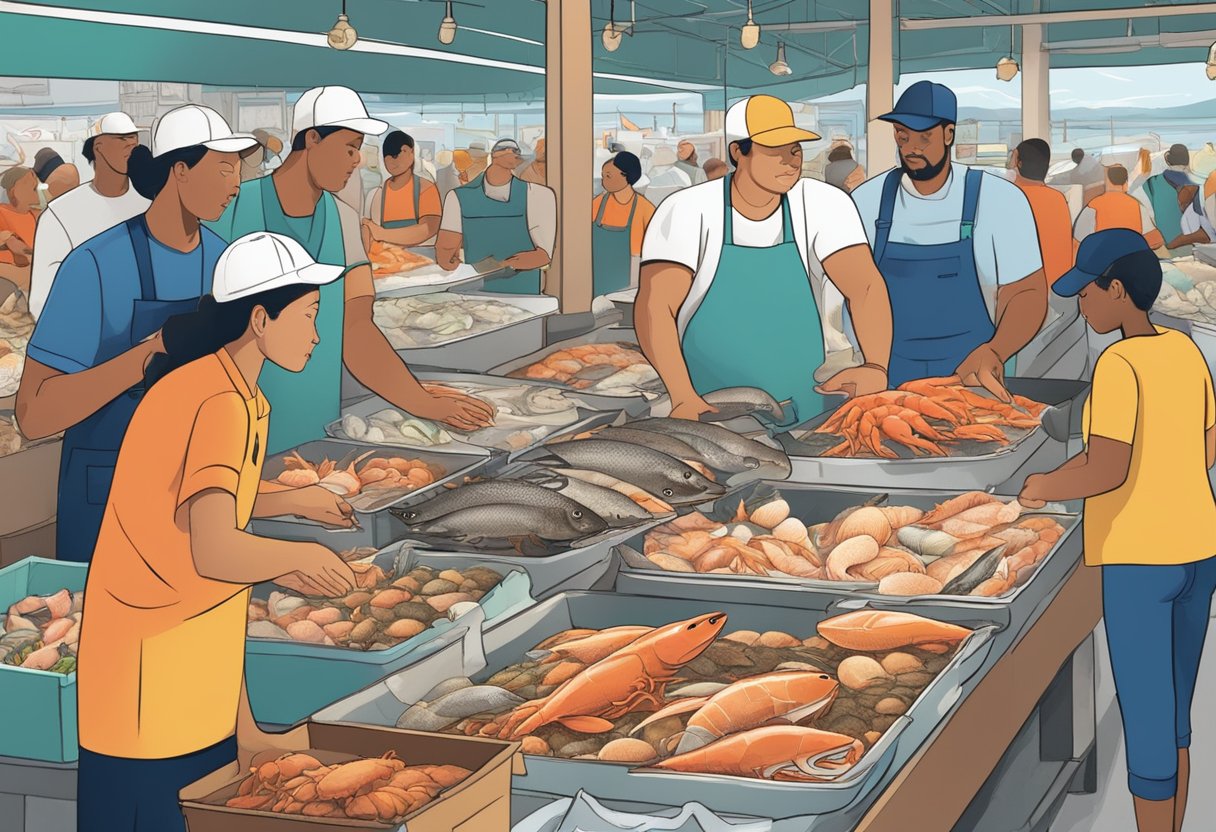Live seafood refers to seafood that is kept alive until it is cooked and served. This is a unique culinary experience that is becoming increasingly popular in Singapore and around the world.
Sourcing live seafood can be a challenge, but there are many suppliers in Singapore that offer high-quality live seafood at reasonable prices. These suppliers use safe handling practices to ensure that the seafood stays fresh and healthy until it is cooked and served. Some of the most popular live seafood options in Singapore include Sri Lanka mud crabs, Boston lobsters, oysters, prawns, salmon trouts, groupers, clams, cod fish, Alaskan King Crabs, abalone, and geoducks.
If you're interested in trying live seafood, there are many culinary experiences to choose from. Some restaurants offer live seafood tanks where you can select your seafood and have it cooked to order. Other restaurants offer live seafood dishes that are prepared in front of you, such as Teochew-style lobster porridge and salted egg yolk crab. Whether you're a seafood lover or just looking for a unique culinary experience, live seafood is definitely worth trying.
Key Takeaways
- Live seafood is seafood that is kept alive until it is cooked and served.
- There are many suppliers in Singapore that offer high-quality live seafood at reasonable prices.
- There are many culinary experiences to choose from when it comes to live seafood, including live seafood tanks and live seafood dishes that are prepared in front of you.
Sourcing Live Seafood

When it comes to sourcing live seafood, there are several factors to consider. From the type of seafood to the source, it's important to ensure that you're getting the best quality possible. Here are some key considerations to keep in mind:
Aquaculture and Wild-Caught
Live seafood can be sourced through aquaculture or wild-caught methods. Aquaculture is the farming of seafood in tanks or ponds, while wild-caught seafood is caught in the ocean. Both methods have their benefits and drawbacks. Wild-caught seafood is often considered to be more sustainable, but can be more expensive and less readily available. Aquaculture, on the other hand, can provide a more consistent supply of seafood, but may be less environmentally friendly.
Regulations and Sustainability
When sourcing live seafood, it's important to consider regulations and sustainability. Look for suppliers who adhere to sustainable seafood practices and who have the necessary certifications. In Singapore, the Agri-Food and Veterinary Authority (AVA) regulates the import and sale of live seafood to ensure that it meets safety and quality standards.
Selecting Quality Live Seafood
When selecting live seafood, look for signs of quality. For lobsters and crabs, choose those with lively and active movements. For oysters, choose those that are tightly closed and heavy for their size. For clams and mussels, choose those with tightly closed shells. For fish, look for clear eyes, shiny scales, and firm flesh.
Storage and Tanks
Live seafood requires proper storage and tanks to ensure its quality and freshness. Tanks should be clean and well-maintained, with the right water temperature and salinity levels. Live seafood should be kept in tanks with enough space to move around and with proper filtration to maintain water quality.
Global Sourcing
Live seafood can be sourced from around the world, with different countries offering different types of seafood. Singapore, for example, is known for its Sri Lankan mud crabs and Boston lobsters. Alaskan king crabs, abalone, and geoducks are sourced from North America. Turbot fish and hairy crab are sourced from China.
Seasonal Availability
Live seafood availability can vary depending on the season. For example, Dungeness crab is typically available from November to June, while bamboo clam is available from June to September. It's important to consider seasonal availability when sourcing live seafood.
Halal-Certified Options
For halal-certified eatery, look for suppliers who offer halal-certified live seafood options. This ensures that the seafood has been prepared according to Islamic dietary laws. Some suppliers in Singapore offer halal-certified live seafood options, such as prawns and scallops.
In conclusion, sourcing live seafood requires careful consideration of several factors, including the type of seafood, source, regulations, sustainability, quality, tanks, global sourcing, seasonal availability, and halal-certified options. By keeping these factors in mind, you can ensure that you're getting the best quality live seafood for your needs.
Culinary Experiences with Live Seafood

Live seafood is a delicacy that is enjoyed by many people around the world. It is a unique culinary experience that offers a fresh and authentic taste that is hard to beat. In this section, we will explore the different ways you can enjoy live seafood, from dining at a restaurant to cooking it at home.
Restaurant Offerings
If you're looking for a memorable dining experience, then live seafood restaurants are the way to go. These restaurants offer a wide range of live seafood, from lobsters and oysters to crabs and abalone. Some of the popular seafood restaurants in Singapore include Orchid Live Seafood, Chin Huat Live Seafood, and The Three Peacocks Live Seafood Restaurant.
Signature Dishes and Preparations
Live seafood restaurants are known for their signature dishes and preparations. Some of the popular dishes include lobster porridge, steamed lobster, and signature Steven chicken. These dishes are prepared using fresh live seafood and are a must-try for any seafood lover.
Home Cooking and Recipes
If you prefer to cook your own seafood, then there are plenty of recipes and cooking techniques to choose from. Some of the popular live seafood options for home cooking include salmon, scallops, prawns, and Sri Lankan mud crab. You can find a variety of recipes online, from simple grilled seafood to more complex dishes like seafood paella.
Cultural Significance
Live seafood has a significant cultural significance in many countries, especially in Asia. It is often served during special occasions and festivals, such as Chinese New Year and weddings. In Singapore, live seafood is a popular choice for family gatherings and celebrations.
Chef Insights and Tips
If you want to learn more about live seafood, then you should seek insights and tips from experienced chefs. They can provide you with valuable information on how to select and prepare live seafood, as well as recommend the best restaurants and suppliers. Some of the top chefs in Singapore include Chef Eric Neo of InterContinental Singapore and Chef Sam Leong of Forest森.
In summary, live seafood is a unique culinary experience that offers a fresh and authentic taste. Whether you prefer dining at a restaurant or cooking at home, there are plenty of options to choose from. So, why not try some live seafood today and experience the flavours for yourself?
Frequently Asked Questions

Where can I find a restaurant that serves live seafood?
If you're looking for a restaurant that serves live seafood, Singapore is the perfect place for you. There are many halal-certified seafood restaurants and stalls that offer a variety of fresh seafood options. Some popular restaurants that serve live seafood include The Three Peacocks Live Seafood Market and Chin Huat Live Seafood. These restaurants offer a wide range of live seafood options including lobsters, crabs, clams, oysters, and prawns. You can choose from a variety of cooking methods such as grilled, steamed, or stir-fried.
How do I ensure the live seafood I order online is fresh upon delivery?
When ordering live seafood online, it's important to ensure that it's fresh upon delivery. Look for a supplier that guarantees the freshness of their seafood and has a good reputation. You should also check the delivery date and time to ensure that the seafood arrives as quickly as possible. Upon delivery, check the seafood for any signs of spoilage such as a strong smell or discolouration. If you have any concerns, contact the supplier immediately.
What should I look out for when selecting live seafood at the market?
When selecting live seafood at the market, there are a few things to look out for. Firstly, check that the seafood is alive and active. If it's not moving or appears sluggish, it may not be fresh. Secondly, check for any signs of damage or injury such as cracks in the shells or missing limbs. Finally, check the colour and texture of the seafood. It should be firm and have a bright colour.
Are there any tips for preparing live seafood at home?
Preparing live seafood at home can be a daunting task, but there are a few tips that can help. Firstly, make sure you have the right equipment such as a sharp knife and a large pot for boiling water. Secondly, clean the seafood thoroughly before cooking. Finally, be careful not to overcook the seafood as it can become tough and rubbery.
Can you recommend a reliable supplier for live seafood?
There are many suppliers of live seafood in Singapore, but it's important to find a reliable one. Some popular suppliers include Seafood Lobang and The Ocean Mart. These suppliers offer a wide range of fresh seafood options and have a good reputation for quality and reliability.
What live seafood options are typically available at wholesale markets?
Wholesale markets in Singapore offer a wide range of live seafood options. Some popular options include lobsters, crabs, clams, oysters, and prawns. These seafood options can be purchased in bulk at a lower price than at restaurants or retail stores. It's important to ensure that the seafood is fresh and of good quality before purchasing.

